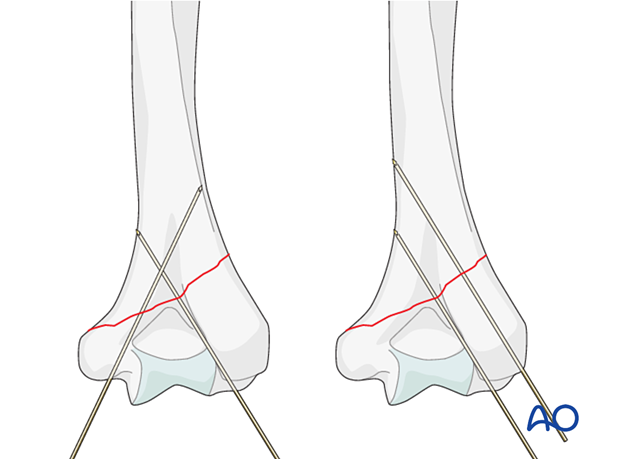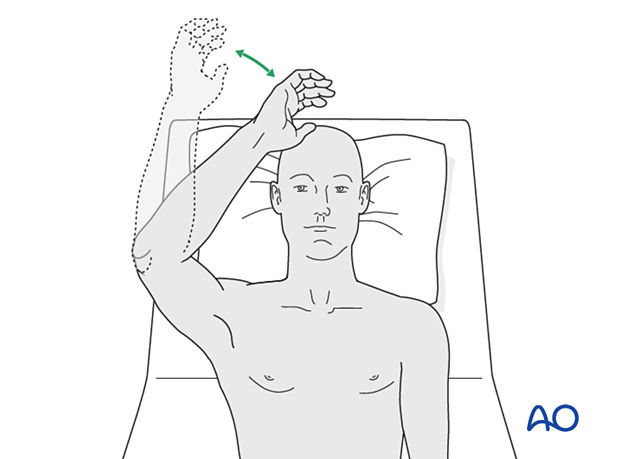ORIF - Plate fixation with/without lag screw
1. General considerations
Introduction
Plating with precontoured periarticular locking plates provides angular-stable fixation and is the most commonly used method of distal humeral fracture fixation.
Treatment principle
The plate should be applied in a compression mode on the side where the fracture plane exits proximally. If more stability is required, a second plate may be applied on the other side.

In the following, the treatment of an obliquely distal and medial fracture is described. The obliquely distal and lateral fracture is treated analogously.

Triangle-of-stability concept
The mechanical properties of the distal humerus are based on a triangle of stability, comprising the medial and lateral columns and the articular block (see also the anatomical concepts).
In principle, for extraarticular fractures, the side of the triangle with the simplest fracture is fixed first.

Plate selection
Precontoured anatomical plates have been designed. If these are not available, a precontoured one-third tubular plate may be used on the crest of the medial supracondylar ridge, and a reconstruction plate on the posterior or lateral aspect of the lateral column. If a stronger plate is required for either column, a small-fragment compression plate may be used, but this is more difficult to contour.
In this procedure, the lateral plate has been chosen to capture the lateral apex of the distal fragment. If the apex is more posterior, a dorsolateral plate may be preferred.
Note: radial nerve at risk

Note: ulnar nerve at risk

2. Patient preparation and approaches
Patient positioning
This procedure is normally performed with the patient either in a prone position or lateral decubitus position.
Approaches
For this fracture pattern, either a triceps-split or paratricipital approach may be used.
If only a lateral plate is to be used, a triceps-on approach is preferred.
If both columns are to be fixed, a triceps-split approach may be preferred.

3. Reduction and temporary fixation
Reduce the main fragments anatomically with manual traction and maintain reduction with a reduction forceps.
Preliminary fixation with axial K-wires may be helpful. To avoid risk to the ulnar nerve, parallel K-wires from laterally may be preferred.
If necessary, check the reduction and provisional fixation with image intensification.

4. Plate fixation
Basic techniques
The basic technique for application of anatomical plates is described in:
If precontoured anatomical plates are not available, see the basic technique for application of reconstruction plates.
Lateral or dorsolateral plate application
Apply a lateral or dorsolateral plate first in compression mode as this is easier to accomplish.
This plate also acts in an antiglide function.

Medial plate application
For further stability, apply a medial plate in either compression or neutral mode (antiglide).

5. Additional lag screw insertion
If the fracture pattern and bone quality allow, insert a lag screw perpendicular to the fracture plane through the plate.

6. Final assessment
Visually inspect the fixation and manually check for fracture stability.
Repeat the manual check under image intensification.
Ensure the ulnar nerve is not unstable or tethered on implants throughout a full range of motion.
7. Aftercare
Introduction
The rehabilitation protocol consists usually of three phases:
- Rehabilitation until wound healing
- Rehabilitation until bone healing
- Functional rehabilitation after bone healing
Immediate aftercare
The arm is bandaged to support and protect the surgical wound.
The arm is rested on pillows in slight flexion of the elbow so that the hand is positioned above the level of the heart.
Short-term splinting may be applied for soft-tissue support.
Neurovascular observations are made frequently.

Hand pumping and forearm rotation exercises are started as soon as possible to reduce lymphedema and to improve venous return in the limb. This helps to reduce postoperative swelling.

Mobilization until wound healing
Gravity-eliminated active assisted exercises of the elbow should be initiated as soon as possible, as the elbow is prone to stiffness:
- The bandages are removed, and the arm rested on a side table
- Flexion/extension of the arm at the elbow is encouraged in a gentle sweeping movement on the tabletop as far as comfort permits (as illustrated)
- Full pronation and supination in protected arm position is encouraged
- Exercises are performed hourly in repetitions, the number of which is governed by comfort
- Between periods of exercise, the elbow is rested in the elevated position for at least the first 48 hours postoperatively
- Keep the arm elevated between periods of exercise until the wound has healed

Rehabilitation until bone healing
Active patient-directed range-of -motion exercises should be encouraged without the routine use of splintage or immobilization.
Avoid forceful motion, repetitive loading, or weight-bearing through the arm.
A simple compressive sleeve can provide proprioceptive feedback which can help regain motion and avoid cocontraction.
No load-bearing (ie, pushing, pulling, or carrying weights) or strengthening exercises are allowed until early fracture healing is established by x-ray and clinical examination.
This is usually a minimum of 8–12 weeks after injury. Weight-bearing on the arm should be avoided until bony union is assured.
The patient should avoid resisted extension activities, especially after a triceps-elevating approach or olecranon osteotomy.
Rehabilitation after bone healing
When the fracture has united, a combination of active functional motion and kinetic chain rehabilitation can be initiated.
Active assisted elbow motion exercises are continued. The patient bends the elbow as much as possible using his/her muscles while simultaneously using the opposite arm to gently push the arm into further flexion. This effort should be sustained for several minutes; the longer, the better.

Next, a similar exercise is performed for extension.

If the patient finds it difficult to accomplish these exercises when seated, then performing the same exercises when lying supine can be helpful.

Implant removal
Generally, the implants are not removed. If symptomatic, hardware removal may be considered after consolidated bony healing, usually no less than 6 months for metaphyseal fractures and 12 months when the diaphysis is involved. The avoidance of the risk of refracture requires activity limitation for some months after implant removal.
8. Case
AP and lateral view of an extraarticular oblique fracture with parallel bicolumnar plate fixation














